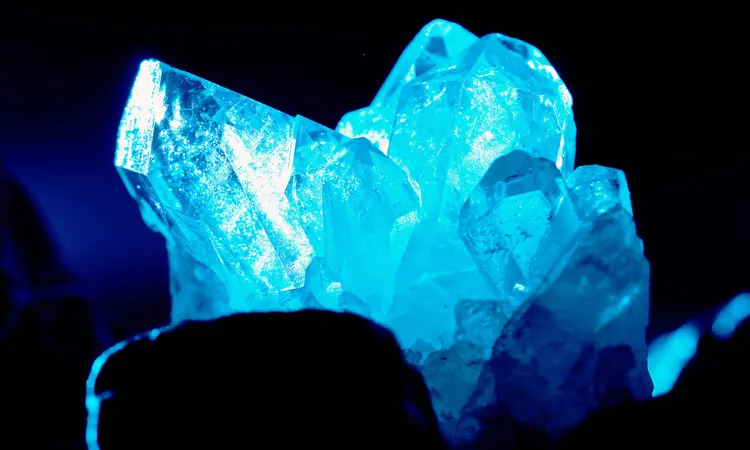
A Bold New Approach: Searching for Dark Matter Inside Ancient Earth Rocks
2024-11-04
Author: Jia
Scientists estimate that we have only observed a mere 5% of the universe, leaving a staggering 95% unaccounted for, primarily believed to be dark matter. This elusive substance does not emit or absorb light, making it extremely difficult to detect using traditional astronomical methods. However, physicist Patrick Huber and his team from Virginia Tech are embarking on a groundbreaking quest that could change our understanding of this cosmic enigma—by searching within billion-year-old rocks and crystals right here on Earth.
Reimagining the Search for Dark Matter
Instead of relying on massive space telescopes or expensive particle accelerators, Huber's unconventional strategy aims to trace dark matter interactions through the ancient geological history of Earth. With substantial support from the National Science Foundation (NSF) and the National Nuclear Security Administration (NNSA), the team is establishing a new laboratory—the heart of their groundbreaking research.
The rationale behind this innovative approach is fascinating: previous experimental setups deep underground, designed to shield from cosmic rays, have failed to provide conclusive evidence of dark matter. Huber's hypothesis is that minuscule disturbances left in ancient crystal structures could serve as potential indicators of dark matter interactions over billions of years.
The Science Behind It
When high-energy dark matter particles collide with the nuclei of atoms within the minerals, they may create subtle disruptions. Collaborator Vsevolod Ivanov explains, “We’ll analyze a crystal that’s been exposed to cosmic particles for millions of years and subtract known distributions. What remains could be evidence of dark matter.”
However, this groundbreaking mission is not without its challenges. One main hurdle is separating possible signals of dark matter from the background noise caused by natural radioactivity. To tackle this, the team is working closely with experts like Robert Bodnar, who is helping identify the most suitable minerals that have kept pristine over millennia.
Cutting-Edge Technology Meets Geology
In a further testament to the interdisciplinary nature of this project, the team uses advanced imaging technologies typically employed in microbiology to visualize these potential dark matter-induced disruptions. They are generating 3D images of particle tracks in synthetic crystals to refine their techniques before applying them to the precious natural samples they hope to study.
Spanning Beyond Dark Matter
Interestingly, the methodologies developed during this research may have practical applications beyond the search for dark matter. Huber hints at the prospect of creating portable devices for nuclear monitoring, a tool that could enhance safety and security at nuclear facilities.
The Lab That Could Unlock Secrets of the Universe
The new facility being constructed at Virginia Tech, supported with approximately $4.25 million in funding, promises to be a cornerstone of innovative research. Huber emphasizes, “This collaboration breaks barriers between physics and geology, creating a fertile ground for groundbreaking discoveries.”
As the team delves into this unique search for dark matter, they remain open to any surprises their research may unearth. Huber reflects, “Science doesn’t always give you what you expect; sometimes, you find entirely new avenues of discovery.
A Journey into the Unknown
While the path ahead is fraught with uncertainty, Huber and his team are undaunted. “We’re exploring the unknown, and that’s where the most exciting discoveries await,” he asserts. If they successfully track down signs of dark matter within ancient rocks, it could open entirely new chapters in cosmology and fundamentally alter our understanding of the universe.
As we stand on the brink of potential revelations that could redefine physics, we can’t help but feel an eager anticipation for what lies beneath our feet. Could it be that the answers to some of the universe's greatest mysteries have been waiting, hidden, in the Earth’s depths all along? Stay tuned as this ambitious team dives into the outer limits of exploration armed with a pickaxe and an unyielding spirit of discovery.


 Brasil (PT)
Brasil (PT)
 Canada (EN)
Canada (EN)
 Chile (ES)
Chile (ES)
 España (ES)
España (ES)
 France (FR)
France (FR)
 Hong Kong (EN)
Hong Kong (EN)
 Italia (IT)
Italia (IT)
 日本 (JA)
日本 (JA)
 Magyarország (HU)
Magyarország (HU)
 Norge (NO)
Norge (NO)
 Polska (PL)
Polska (PL)
 Schweiz (DE)
Schweiz (DE)
 Singapore (EN)
Singapore (EN)
 Sverige (SV)
Sverige (SV)
 Suomi (FI)
Suomi (FI)
 Türkiye (TR)
Türkiye (TR)